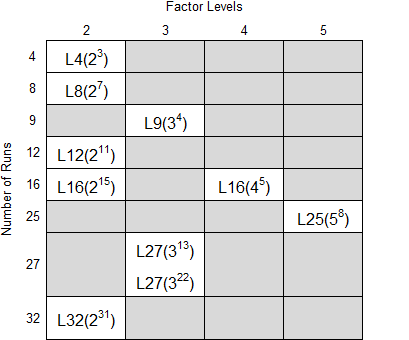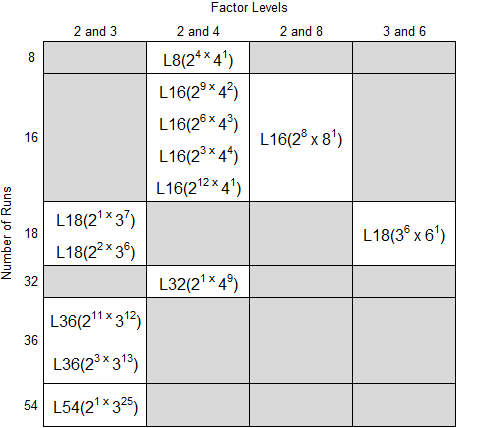Taguchi Orthogonal Array (OA) Factorial Designs
Taguchi orthogonal array (OA) factorial designs are highly fractional designs that allow you to consider a selected subset of combinations of multiple factors run at different numbers of levels. The number of factors that can be considered is dependent on the factor levels used.
Orthogonal arrays are balanced to ensure that all levels of all factors are considered equally. For this reason, the factors can be evaluated independently of each other despite the fractionality of the design. The available designs are based on the design matrix created by Genichi Taguchi.
Available Taguchi OA Designs
The available single level and mixed level Taguchi OA designs are shown next. This information is applicable to designs with standard response data, as well as robust parameter designs and reliability DOE.
Single Level Designs

These tables provide information about the available combinations of the number of factor levels and the number of runs. In the design notation, the value immediately following L represents the number of runs used in the design. Within the parentheses, each base value represents a number of levels and each exponent represents a number of factors. For example:
- The L8(27) design uses eight experimental runs to investigate up to 7 two-level factors.
- The L8(24 x 41) design uses eight experimental runs to investigate up to 4 two-level factors and 1 four-level factor.
The ReliaWiki resource portal provides the design tables for all of these Taguchi OA designs at: http://www.reliawiki.org/index.php/Taguchi_Orthogonal_Arrays.
The alias relations are given at: http://www.reliawiki.org/index.php/Alias_Relations_for_Taguchi_Orthogonal_Arrays.